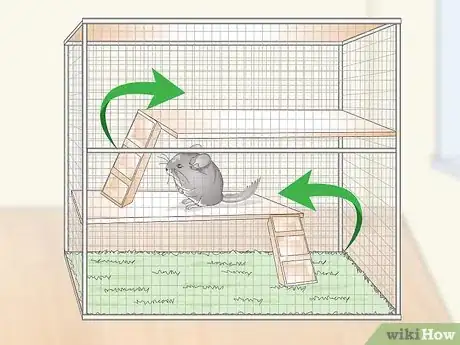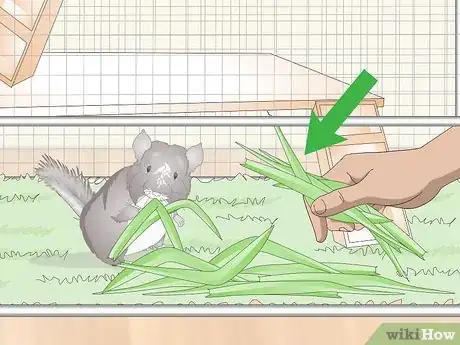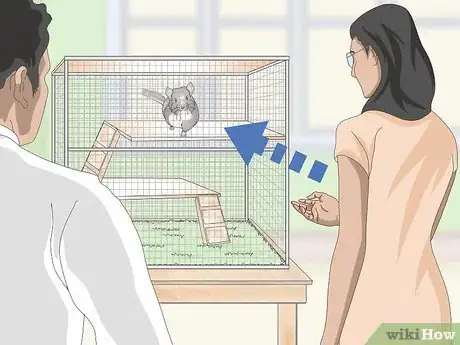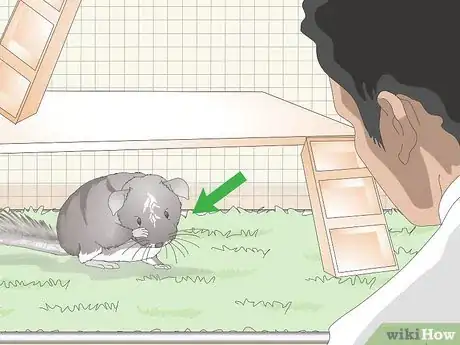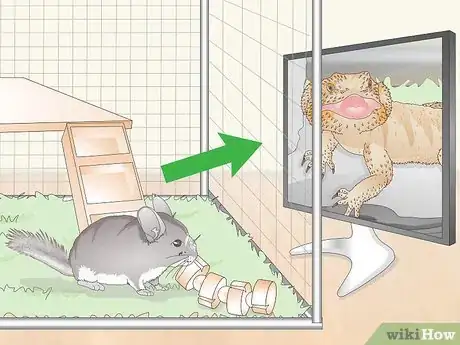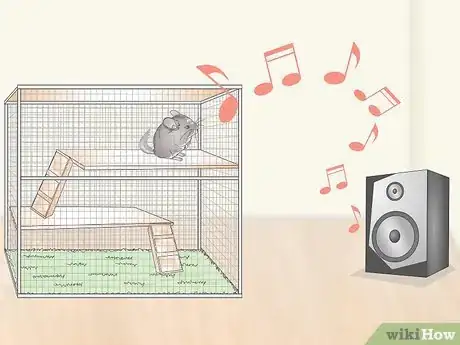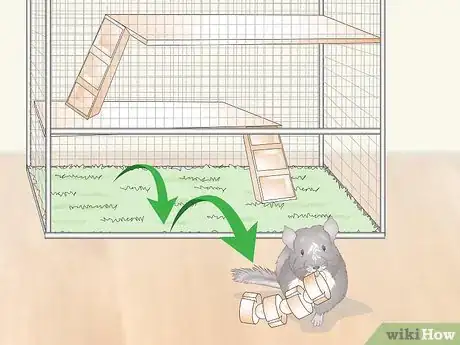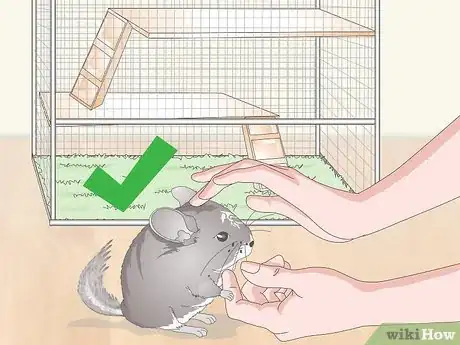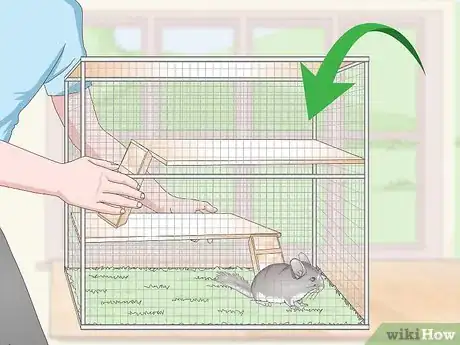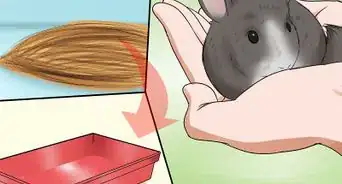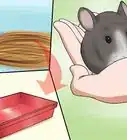This article was co-authored by wikiHow Staff. Our trained team of editors and researchers validate articles for accuracy and comprehensiveness. wikiHow's Content Management Team carefully monitors the work from our editorial staff to ensure that each article is backed by trusted research and meets our high quality standards.
This article has been viewed 25,351 times.
Learn more...
Chinchillas are very adorable and interesting animals to keep as pets. However, unlike cats or dogs, taking care of chinchillas can be a lot of hard work if you are not properly prepared. They are delicate creatures that can be quite sensitive to a lot of things in their environment. Here are some things that can help you keep your chinchilla calm and happy, while fostering a good relationship with it.
Steps
Understanding Your Chinchilla's Needs
-
1Have a cage that is large enough for your chinchilla. Chinchillas are quite active and they like to hop, jump and run around at high speed. It is important that your chinchilla is not restricted from doing these things. Make sure that the cage has enough space for it to move about and play.[1]
- It is also recommended to provide your chinchilla with a hideaway spot in its cage. Chinchillas can be shy and often like to have their own privacy away from any social contact or interaction.[2] Have a small tube or tunnel in your chinchilla's cage so that it can have some alone time whenever it pleases.
-
2Maintain a safe room temperature for your chinchilla. Chinchillas become uncomfortable in high temperatures and cannot survive if the temperature rises over 75 degrees Fahrenheit. Make sure to keep your chinchilla's cage in a room that is kept well below this temperature.
- Have some emergency marble tiles in your freezer for situations where your chinchilla gets overheated. Gently place your chinchilla on top of the marbles to cool it down.
Advertisement -
3Feed your chinchilla with foods that are high in plant fibre. Chinchillas classify as herbivores that produce Cecotropes, which are faecal pellets that they eat and digest before producing smaller and drier pellets.[3] This special digestive process requires them to have a diet that is rich in fibre. It is therefore important that your chinchilla has good access to fresh and dust free grass, as well as an abundance of hay.[4]
- You can also give small amounts of herbs and leafy greens to your chinchilla as treats throughout the day.
-
4Encourage foraging behaviour. You can make things more interesting for your chinchilla by providing an outlet for natural foraging behaviour. Scatter food pellets around your chinchilla's cage and hide bits of hay or leaves in different spots for it to find.[5] This is good for your chinchilla because it mimics behaviour that would typically be displayed in the wild.
-
5Introduce changes in the environment gradually. Chinchillas are quite sensitive to things in their environment, particularly new situations or anything that they are unfamiliar with.This can include being around people that they are not used to or a change in their living space. Gradually making changes will reduce stress levels and also prevent your chinchilla from experiencing shock.
- If you need to replace some structures in your chinchilla's cage, be sure to do so one structure at a time with some time in between. This will allow your chinchilla to get used to its new surroundings.
-
6Observe your chinchilla's body language in different situations. Your chinchilla's emotional state will typically show in its body language or posture. For example, if it is frightened, it will crouch down and lower its ears. It will also show signs of frustration when it does not receive enough physical or mental stimulation, such as gnawing at or shaking its cage bars.[6]
- Make sure that you are able to react accordingly and make necessary adjustments when your chinchilla displays signs of stress or discomfort.
Making Your Chinchilla Feel Comfortable
-
1Provide distracting stimuli. Chinchillas are highly intelligent creatures and they need to constantly be active. Give your chinchilla some toys to chew on or place it in view of a television to prevent it from getting bored. Keeping your chinchilla busy and entertained will also allow it to develop in a healthy way.
- If left with nothing interesting to do, chinchillas may end up creating trouble or engaging in problematic behaviours such as fur biting.
-
2Play some relaxing music. Music therapy plays a major role in relieving stress not just for chinchillas but a lot of animals, even humans.[7] You can play music for your chinchilla to help it sleep, or even while it is playing outside of its cage to help it feel comfortable in its surroundings.
- There is music available online that is specifically made for helping chinchillas relax.[8] Pet Tunes is a company that produces music and videos that are designed to help relief stress and anxiety in pets.
-
3Give your chinchilla enough playtime outside of its cage. It is essential for chinchillas to get some time to play and explore their environment. Let your chinchilla out of its cage at least in the evening, or leave its cage door open once in a while so it can have the freedom to come and go as it wishes.[9]
- Chinchillas like to chew and bite things as part of their exploration. Bear in mind that you should not have anything in the room that could be dangerous for your chinchilla.[10]
- Your chinchilla will be the happiest when it is allowed to do things in its own time and play in an environment that is safe and familiar to it.
-
4Bond with your chinchilla. The best time to bond with your chinchilla is during playtime outside of its cage. Use this time not only to allow your chinchilla to explore and play but also to build a good relationship with it.[11] Give your chinchilla a little cuddle or let it take a ride on your shoulder.
- While your chinchilla is running around, let it take the initiative in approaching you. This builds trust and allows your chinchilla to be more comfortable around you.
-
5Try changing the location of its cage. To keep things exciting for your chinchilla, you might want to try moving its cage to a different part of the room. This type of change is often met with enthusiasm as the chinchilla will still be able to recognise the same environment. As long as the change is non-threatening and small enough for the chinchilla to adjust with time, you will end up with a happy and satisfied pet.
Warnings
- Despite looking adorable, chinchillas are not children's pets. They very rarely wish to be held or cuddled especially if they are not comfortable with the individual.[12]⧼thumbs_response⧽
- Caring for chinchillas is not easy and requires a lot of patience and discipline. Be sure that you are ready to commit to the task before deciding to get a chinchilla as a pet.⧼thumbs_response⧽
References
- ↑ https://www.caringpets.org/how-to-take-care-of-a-chinchilla/
- ↑ https://www.medvetforpets.com/chinchilla-history-care-sheet/
- ↑ https://www.apbc.org.uk/wp-content/uploads/APBC-Article-Chinchilla.pdf
- ↑ https://www.apbc.org.uk/wp-content/uploads/APBC-Article-Chinchilla.pdf
- ↑ https://www.apbc.org.uk/wp-content/uploads/APBC-Article-Chinchilla.pdf
- ↑ https://www.apbc.org.uk/wp-content/uploads/APBC-Article-Chinchilla.pdf
- ↑ https://www.youtube.com/watch?v=Az-7qNRCz5c
- ↑ https://www.youtube.com/watch?v=Az-7qNRCz5c
- ↑ https://www.apbc.org.uk/wp-content/uploads/APBC-Article-Chinchilla.pdf
